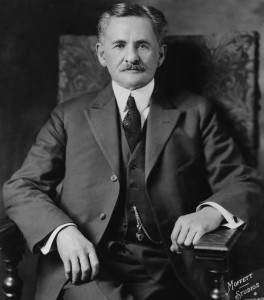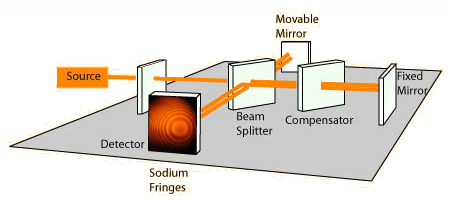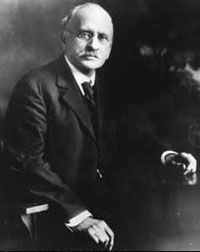03 Jul The Michelson-Morley Experiment

Albert Michelson
The story of relativity did not begin in 1905. It started in 1881 with an experiment that yielded very surprising results – results that helped lead Einstein to his theory. The experiment was inspired by a proposal made by James Maxwell to determine the earth’s motion through the ether (which was still believed in at the time) by measuring the speed of light in two directions: one parallel to the earth’s motion and the other perpendicular to that motion. By comparing these two measurements, one should be able to calculate the speed of the earth as it passes through the ether. However the measurement accuracy that would be needed (one part in 200 million) was well beyond the capability of the time, so Maxwell concluded that the experiment was impossible. It took a young American physicist to make it possible, and the result that he found caused a revolution in physics unlike any seen before.
Albert Michelson came to the United States at the age of two, the son of Jewish-German parents. After serving in the US Navy (which he rejoined at the age of 62 to serve in World War I) he pursued a career in physics. In 1881, while studying in Europe, he came across Maxwell’s “challenge” and conceived the idea of the interferometer – an instrument that can measure exceedingly small distances by observing optical interference patterns. Using this sensitive instrument, Michelson was able to perform Maxwell’s experiment.

The central part of the apparatus is a thinly-silvered mirror that splits a light beam into two parts, with one beam traveling through the mirror and the other reflected upward. The two beams are then reflected back to the central mirror, which sends them to a detector. The light paths are equal in length so that if the apparatus is stationary the light beams would take equal times to reach the detector. However if the apparatus is moving, the beam traveling in the direction of motion would have to cover a greater distance because the mirrors and detector move during the time of travel. The transverse beam would also be affected by motion, but not as much. (You can either take my word for this or work it out with some high school algebra.) The resulting difference in travel times would put the beams “out of phase” and would create an interference pattern when they combine at the detector.

Edward Morley
When the experiment was performed, much to Michelson’s surprise there was no difference between the two directions! The two light beams took the same time to reach the detector despite the extra distance created by the earth’s motion. More accurate experiments were performed later in collaboration with Edward Morley, using more mirrors to extend the path lengths. This improvement in accuracy turned out to be critical, as Michelson had made an error in his first measurement that was pointed out by Hendrik Lorentz. The experiment, now called the Michelson-Morley (M-M) experiment, was repeated many times – at different times of day (as the earth’s surface moves in different directions because of its rotation) and at different seasons of the year (when the earth moves in different directions as it orbits the sun). The answer remained the same: The two light beams took equal times to traverse their paths, regardless of the earth’s motion.
That the speed of light should be independent of motion was most surprising… It makes no sense for a light beam – or anything, for that matter – to travel at the same speed regardless of the motion of the observer. Suppose, for example, that you are observing a very fast train from another train. The apparent speed of the fast train would clearly depend on its direction relative to yours. If the other train is moving in the opposite direction, it would go whooshing by, but if it is moving in the same direction as you, it would pass very slowly. Yet Michelson, a passenger on a train called earth, found that another train called light always moves at the same speed no matter which way it is moving relative to the earth.
If the M-M experiment had been performed only once, there would have been no problem. We could have simply said this is the frame of reference in which the laws of physics hold, in which Maxwell’s equations apply and light travels with velocity c. But the experiment was repeated with the earth moving in different, and even opposite, directions and the result was always the same. It is not possible for light to travel with the same velocity in all of these frames of reference unless “something funny” is going on.
The “something funny” turned out to be even more surprising than the M-M result itself. In a nutshell, objects contract when they move! More specifically, they contract in the direction of motion. Think about it. If the path length of Michelson’s apparatus in the forward direction contracted by the same amount as the extra distance the light beam would have to travel because of motion, the two effects would cancel out. In fact, this is the only way that Michelson’s null result could be explained.

Sorry, the comment form is closed at this time.